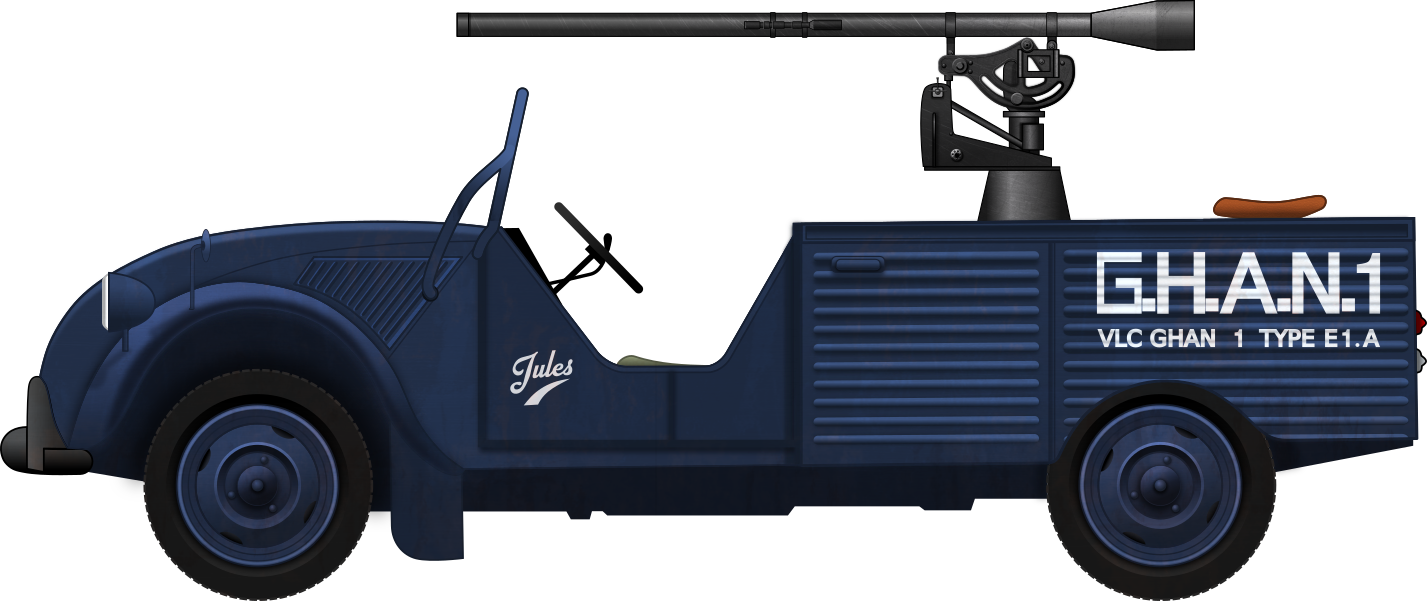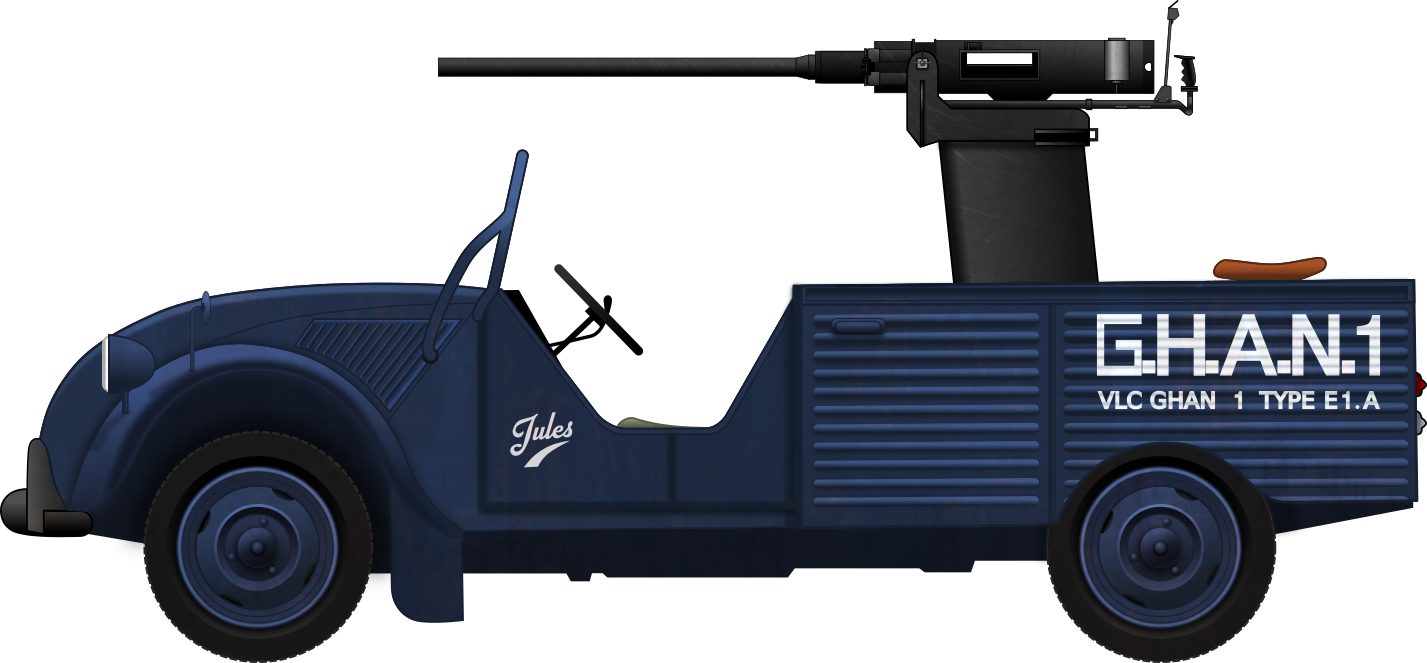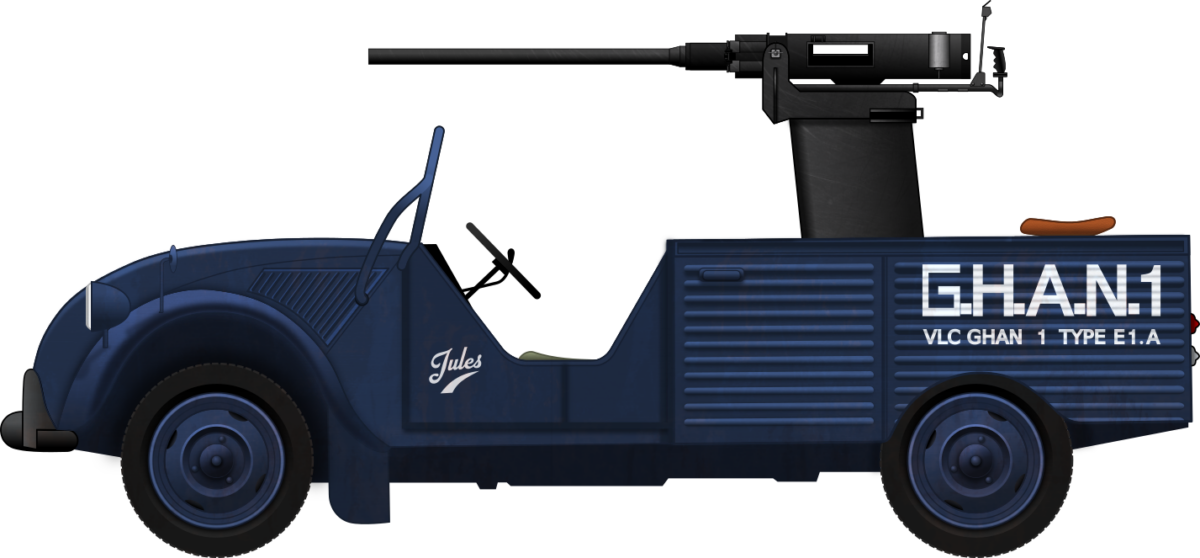 France (1959-1961)
France (1959-1961)
Armed Air-Transportable Car – 1 Converted
The Citroën 2CV is arguably the most famous French car in history. Designed by Citroën’s vice president in the late 1930s and produced from 1948 onward, the small car was originally conceived to offer a very cheap and simple design for French farmers and rural communities, but it would find success far beyond rural communities and all the way to the French Navy’s airborne services.

The Algerian War, the French Navy, and its Helicopters
French colonization of the territory which would become the country of Algeria began in 1830. One of the colonies closest to mainland France, just across the Mediterranean, Algeria would soon become one of the jewels in the crown of France’s colonial empire. Progressively, Algeria’s European population grew, far more than other French African colonies. Nonetheless, as the tide of anti-colonial pro-independence movements swept all across the vast French colonial empire, tensions soon grew in Algeria. While the neighboring protectorates of Morocco and Tunisia were granted independence in 1956 in a mostly peaceful process, this was not the case for Algeria. Independence groups in Algeria were faced with ruthless crackdowns, leading to the situation in Algeria developing into war between the French armed forces and the independence movement (the FLN, Front de Libération National, Eng: National Liberation Front, and its armed wing, the ALN, Armée de Libération Nationale, Eng: National Liberation Army)
Though the Algerian conflict was never described as a war in France during its duration, it resulted in the mass mobilization of the French Army against the FLN, with over 450,000 soldiers in Algeria at any time between 1956 and 1962 (including a large number of conscripts), and about 1,5 million Frenchmen having being mobilized by the Army in Algeria during the duration of the war, which only concluded in 1962.
This Algerian conflict saw the French make heavy use of helicopters, most commonly the American-built Sikorsky H-34 and its variants, and, from 1957 onward, the French-built Alouette II. Within the services of the French military which operated helicopters were ‘flotillas’ of the French Navy: the 31F, which was created in June 1955; 32F, created in June 1957; and the 33F, created in January 1958. Though the 31F first operated Piasecki H-21 and the 33F the Sikorsky H-19s, all three flotillas were eventually equipped with the Sikorsky HSS-1, the naval variant of the H-34.

The three helicopter flotillas were put under a unified command on 1st November 1957, forming the Groupement des hélicoptères de l’Aéronautique Navale n°1, or GHAN 1 (Eng: Naval Aviation Helicopter Group). It most commonly operated alongside the DBFM, Demi-brigade de Fusiliers Marin (Eng: Navy Riflemen Half-Brigade), a unit created in 1956 and comprised three naval infantry battalions and five additional companies. The DBFM mostly operated in the northwest of Algeria, around the large city of Oran, and near the Moroccan border. The helicopters of the GHAN 1 were often used to support it. The HSS-1 could be used for troop transport or medical evacuation but was also used for fire-support duties. One helicopter in each of the three helicopter flotillas was fitted with an MG 151/20 20 mm autocannon of German origin. Those helicopters were named Couleuvrine-Canon (31F), Rameur-Canon (32F) and Barlut-Canon (33F).


Lieutenant Commander Babot and the Armed 2CV
On 26th September 1959, command of the GHAN 1 was granted to a Capitaine de Corvette (Eng: corvette captain, the equivalent rank generally being lieutenant commander) Eugène Babot, a Free French Navy and Indochina veteran. Babot appears to have been the one to decide to arm three helicopters of the GHAN 1 with MG 151/20 20 mm autocannons. He also initiated the search for a light-armed vehicle that could be air-transported by the HSS-1 helicopters of the GHAN.
Babot was quick to consider the ubiquitous French car of the era, the Citroën 2CV, a small, rustic car in production since 1948 which had been designed for rural use. He imagined that, stripped of most of its body, the 2CV would provide a very light platform that could potentially be fitted with some form of weaponry. The particular type of 2CV which was used appears to be a 2CV AZU, a utility vehicle that replaced the rear seats for storage space. This vehicle type was very widely used by French shopkeepers. The engine used on the vehicle in the late 1950s and early 1960s production was a boxer-two cylinder 425 cm3 gasoline engine producing 12 hp. At 530 kg, a 2CV AZU was a particularly light vehicle. It was 3.6 m long, 1.48 m wide, and 1.7 m tall.

Modifying the 2CV
In order to reduce the weight of the vehicle as much as possible, as well as make it a more suitable platform for armament, the personnel of GHAN1 would cut away most of the upper body of the vehicle. Pretty much everything above the driving wheel was removed, as was almost all the roof and rear superstructure and the passenger seat mounted at the front.
The original windshield was entirely removed, alongside the upper body of the vehicle, but instead of simply having the front being entirely open, a small, centrally-mounted glass windshield was added, reinforced by two support bars that connected with it on the upper sides.

The rear of the vehicle was modified to create an open space, pretty much a pickup configuration. This was made much simpler by the use of an AZU utility vehicle. Creating an empty space at the rear was pretty much as simple as removing the roof. The lower sides of the body, made of sheet metal, were retained to form a barrier for the armament section of the vehicle.
This open rear space was used to install an armament mount. This was a cut-cone shape mount, quite similar in general appearance to the one that could be found on many warships from the early 20th century. On top of this mount, a rotating support was mounted, on which the weapon which was chosen to be employed would be placed. A seat was mounted to the rear of this pedestal mount, but was not rotatable. When firing towards the sides, the gunner would instead lay on the vehicle’s sides. The combat crew for the vehicle would have been of two, a driver and a gunner.

The modified 2CV was nicknamed ‘Jules’, Captain Babot’s radio code. The vehicle was given a registration number of “442 433”, painted on the rear left of the vehicle’s side and present on the frontal registration plate. On top of this registration number, a French flag and an anchor, a commonly used symbol of the DBFM, were drawn. The vehicle was painted in a sea blue color. On the rear sides, “GHAN 1” was inscribed in white, as well as an inscription that appears to read “Vle GHAN1 type G1A.”. The Vle likely was an abbreviation for véhicule (Eng: vehicle), with the inscription being a designation given to the vehicle, despite its ad hoc nature.
The weight of the vehicle is unknown, but it was said to be considerably lighter than a Jeep (most likely either a Willys MB or the Hotchkiss license-built variant, the M201), which weighed around 1.1 tonnes. A base AZU was 530 kg, and while the armament would make the vehicle heavier, this was offset by the removal of much of the body as well as one of the vehicle’s seats. The weight at around half a tonne could have been a realistic prospect for the vehicle.
Armament Options
The 2CV fire-support vehicle was tested with a variety of different armaments.


The first option available to the vehicle consisted of recoilless rifles. It is mentioned that the vehicle was tested with two different recoilless rifles, a 57 mm one (the American M18) and a 75 mm one (the American M20). All known photos of the vehicle armed with a recoilless rifle appear to show it with the larger M20.
The main advantage of the M20 was the low weight (47 kg) of the weapon in relation to the large size of the projectiles it could fire. The gun fired 75×408 mmR shells. A variety of shells existed for the gun, including High-Explosive Anti-Tank (HEAT), High-Explosive Plastic (HEP, often better known under the British designation of HESH), and smoke shells. Considering the French Army’s operations in Algeria, with no ALN armor and little fortifications to speak of, the most commonly used shell was without a doubt the High-Explosive (HE) projectile. This was designated as T38 or M48. The round had a complete weight of 9.91 kg, with the shell and fuze weighing 6.53 kg. The explosive charge had 676 g of TNT. The maximum effective direct-fire range was considered to be about 1 km, though the gun could also be used in an indirect fire role at ranges up to 3 km. Though the gun had a quite short range, the firepower it offered in comparison to its lightweight was considerable.





The 75 mm M20 appears to have been mounted on the 2CV for a while, and a variety of photographic views of the vehicle have surfaced with such armament. However, it appears there were some issues with this configuration. Despite being recoilless, the M20 still caused vibrations that would have over time likely have proved damaging to the car’s frail suspension.
As such, it appears the preferred option for the vehicle’s armament was instead automatic armament. The automatic weapon armed 2CV should not be considered as merely a successor of the M20 armed 2CV, as it appears both armaments were considered for a time and could be swapped depending on which would have been preferable in any given situation.
The automatic weapon on the 2CV was the German MG151/20 20 mm autocannon. This German aviation gun was widely used in a variety of roles in post-war France. Inside helicopters, like those used by GHAN1, the autocannon was first used with a 60-80 round belt, and later, because of more advanced mounts, a much larger 500-rounds belt. Inside the 2CV GHAN1 vehicle, the shorter belts appear to have been more likely to be used due to the more limited space.
The MG151 fired at a rate of fire of 600 rounds per minute, with muzzle velocities of 700 to 785 m/s. The gun weighed 42 kg. There was a variety of high-explosive ammunition available for the type, with the shells generally having either 20 g or 25 g of high-explosive filler. The French considered the gun to be surprisingly sturdy and reliable even in the dust and sand-filled environments of rural Algeria. It was noted as being easy to operate by a single crew member, even when in flight, so in a support vehicle like a 2CV, that would likely not have been an issue either.




Unlike the M20, however, the MG151 was not at all a recoilless weapon. From the existing photographs, it appears that firing over the sides would make the vehicle quite unstable and even lifted the rear wheel of the direction the gun was firing towards in the air by some extent. Still, the firepower provided by such a gun being mounted on a vehicle as light as the 2CV was once again very considerable.
La Terreur du Djebel?
The Jules conversion appears to have taken place sometime in or around 1960.

The vehicle was employed between 1960 and 1961. Plenty of firing trials were carried out, in which Captain Babot was directly involved, sometimes serving as the gunner of the vehicle. Interestingly enough, the unit also carried out air-transportability experiments. For this purpose, the vehicle was lifted under a Sirkorski helicopter by several cables, with seemingly a mounting point on each of the vehicle’s wheels, one on the rear, one on the gun, and possibly more.

At the time, the vehicle already appeared to have been considered as somewhat of a curiosity in the hands of GHAN1. It does not appear the conversion was actively used in combat. Nonetheless, when recounting it, veterans of GHAN1 appear to affectionately give it the nickname of “Terreur du Djebel” (Eng: Terror of the Djebel, Djebel being a word taken by the French from Arab which designates mountains in the Middle East and North Africa).
A 2CV Disappearing into the Sands
Captain Babot was relieved from command of the GHAN1 on 17th July 1961. Seemingly, around the same time, the trail of the armed 2CV goes cold.
What eventually happened to the vehicle is entirely unknown. It may have had its armament removed and used as a pickup truck, lost due to an accident or breakdown, or abandoned in Algeria. Though one cannot exclude the possibility it was shipped back to France during the French Army’s retreat from Algeria in 1962, this would likely have been known and captured on camera. There is no evidence of that ever happening.
The vehicle, as such, forever remains a curiosity, of the time the 2CV, one of the most famous and popular French cars of the 20th century, got turned into an armed vehicle for warfare in Algeria. This is, surprisingly enough, not the only time the 2CV was used by a military. Some vehicles were used as air-transportable pickups by no other than Royal Navy Commandos, with these unarmed vehicles seemingly seeing service during the quelling of the Malayan Insurgency, in a fairly similar timeframe to the Algerian War. In modern times, a replica of the vehicle appears to have shown up in a number of French classic cars meetups.



2CV GHAN1 Specifications |
|
| Length | ~3.6 m |
| Width | ~ 1.48 m |
| Engine | 425 cm3, 2-cylinders Boxer gasoline engine producing 12 hp |
| Weight | Less than a tonne, perhaps as light as around 500 kg |
| Crew | Likely 2 (driver, gunner) |
| Armament | Alternatively: M18 57 mm recoilless rifle (reported, never seen) M20 75 mm recoilless rifle Mauser MG151/20 autocannon |
| Armor | None |
| Numbers converted | 1 |
Sources
Veterans testimonies on paras.forumactif.net
On chemin-de-memoire-parachutistes.org


3 replies on “Citroën 2CV GHAN1”
http://www.citroenet.org.uk/foreign/slough/rn-pickup/pick-up.html
I suspect the nickname “Terreur du Djebel” was intended to be ironic….
the caption of the vehicle in testing says that the man firing the 2CV’s gun was a ‘captain’ but the original caption says the rank is ‘corvette captain’